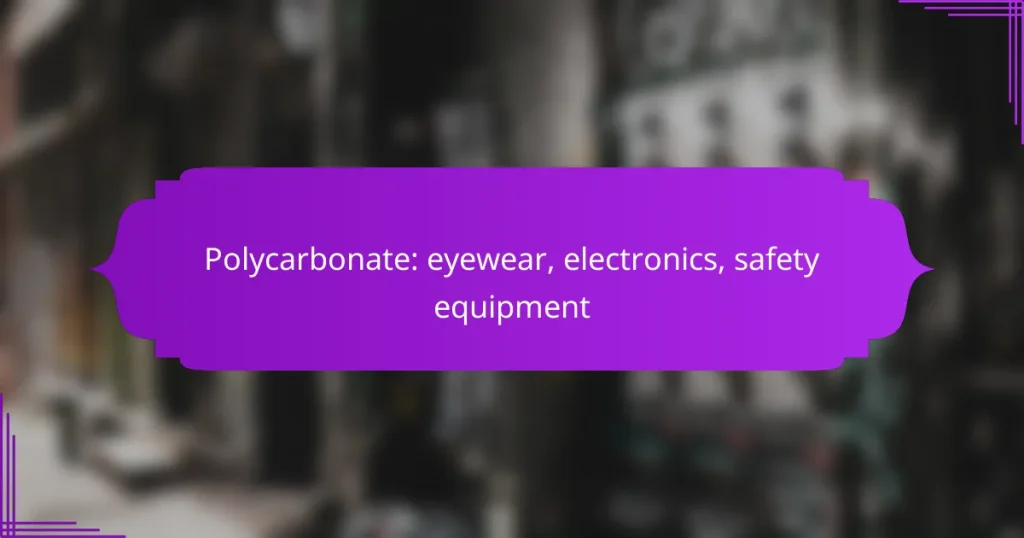Polycarbonate is a versatile and lightweight material known for its exceptional impact resistance, making it an ideal choice for eyewear, electronics, and safety equipment. In eyewear, brands like Oakley and Ray-Ban leverage polycarbonate’s durability and UV protection to enhance both performance and style. Its clarity and strength also make it a preferred option for safety glasses and various electronic components, ensuring reliability in demanding environments.
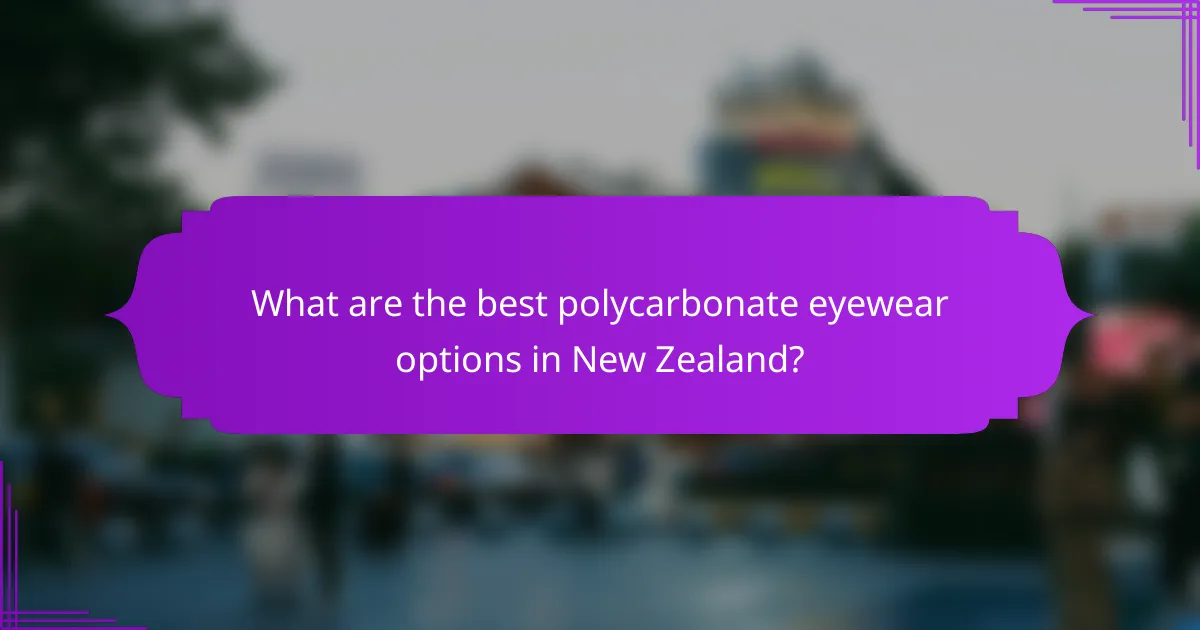
What are the best polycarbonate eyewear options in New Zealand?
The best polycarbonate eyewear options in New Zealand combine durability, lightweight comfort, and UV protection. Popular brands include Oakley, Ray-Ban, and Persol, each offering unique features suited for various activities and styles.
Oakley polycarbonate sunglasses
Oakley is renowned for its high-performance polycarbonate sunglasses, ideal for sports and outdoor activities. Their lenses provide excellent impact resistance and clarity, making them suitable for athletes and enthusiasts alike.
When choosing Oakley sunglasses, consider the lens tint and polarization options to enhance visibility and reduce glare. Many models also feature adjustable nose pads for a customized fit, ensuring comfort during extended wear.
Ray-Ban polycarbonate lenses
Ray-Ban offers a stylish range of eyewear with polycarbonate lenses that balance fashion and functionality. These lenses are lightweight and provide robust UV protection, making them a popular choice for everyday use.
Look for Ray-Ban models that include anti-reflective coatings for improved visibility in bright conditions. Their classic designs, such as the Wayfarer and Aviator, are versatile and can suit various face shapes and personal styles.
Persol polycarbonate eyewear
Persol is known for its premium polycarbonate eyewear that combines Italian craftsmanship with innovative technology. Their lenses are designed to provide superior optical clarity and are often equipped with features like polarized options for enhanced vision.
When selecting Persol eyewear, pay attention to the frame styles and color options available. Their unique folding designs and signature arrow detail add a touch of elegance, making them suitable for both casual and formal occasions.

How does polycarbonate compare to other eyewear materials?
Polycarbonate is a lightweight and impact-resistant material that offers significant advantages over traditional eyewear materials like glass and plastic. Its durability and clarity make it a popular choice for safety glasses, sports eyewear, and everyday glasses.
Polycarbonate vs. glass lenses
Polycarbonate lenses are much lighter and more shatter-resistant than glass lenses, making them ideal for active lifestyles and safety applications. While glass provides superior optical clarity, it is prone to breaking and can be heavier, which may cause discomfort during extended wear.
For those who prioritize safety, polycarbonate lenses meet ANSI Z87.1 standards for impact resistance, while glass lenses do not offer the same level of protection. This makes polycarbonate a preferred choice for environments where eye safety is critical.
Polycarbonate vs. plastic lenses
Compared to standard plastic lenses, polycarbonate lenses are more durable and resistant to scratches and impacts. Plastic lenses are typically less expensive but can be more prone to damage, which may necessitate more frequent replacements.
Polycarbonate lenses also provide UV protection, which is essential for outdoor use, while many plastic lenses may lack this feature unless treated. When choosing between the two, consider your lifestyle and how often you engage in activities that could lead to lens damage.
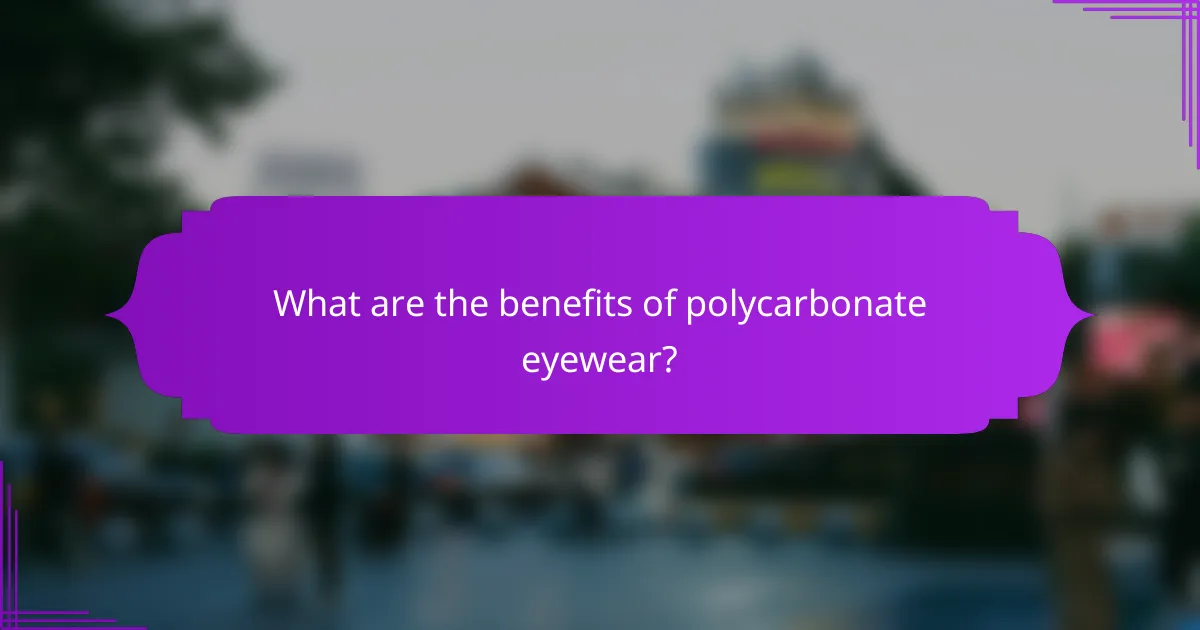
What are the benefits of polycarbonate eyewear?
Polycarbonate eyewear offers significant advantages, including high impact resistance, a lightweight design, and built-in UV protection. These features make polycarbonate lenses an excellent choice for safety glasses, sports eyewear, and everyday use.
Impact resistance
Polycarbonate is known for its exceptional impact resistance, making it nearly unbreakable compared to traditional glass or plastic lenses. This property is particularly beneficial for safety eyewear, where protection from flying debris or accidental drops is crucial.
Many polycarbonate lenses meet or exceed safety standards such as ANSI Z87.1 in the United States, ensuring they can withstand high-velocity impacts. This makes them ideal for use in industrial settings or during sports activities.
Lightweight design
One of the standout features of polycarbonate eyewear is its lightweight nature. Polycarbonate lenses are significantly lighter than glass or standard plastic lenses, which enhances comfort for prolonged wear.
This lightweight design is particularly advantageous for those who wear glasses all day, as it reduces the pressure on the nose and ears. Users often report a more comfortable fit, which can lead to less fatigue during extended use.
UV protection
Polycarbonate lenses inherently provide UV protection, blocking up to 100% of harmful UV rays. This feature is essential for protecting the eyes from sun damage, which can lead to conditions like cataracts over time.
When selecting polycarbonate eyewear, look for lenses that specify UV protection to ensure optimal safety. This is especially important for outdoor activities, where exposure to sunlight is prolonged.

What are the applications of polycarbonate in electronics?
Polycarbonate is widely used in electronics due to its durability, lightweight nature, and excellent impact resistance. Common applications include smartphone screens and laptop casings, where it provides protection and clarity while maintaining a sleek design.
Polycarbonate in smartphone screens
Smartphone screens often utilize polycarbonate for its shatter-resistant properties, making devices safer and more durable. This material can withstand drops and impacts, reducing the risk of screen damage.
When selecting polycarbonate for smartphone screens, consider factors like thickness and coating options. Thicker sheets can offer better protection, while anti-scratch coatings enhance longevity. Many manufacturers opt for polycarbonate over glass to achieve a balance between weight and strength.
Polycarbonate in laptop casings
In laptop casings, polycarbonate is favored for its lightweight and robust characteristics, allowing for portable yet sturdy designs. This material helps protect internal components from physical damage while maintaining a sleek appearance.
When choosing polycarbonate for laptop casings, evaluate the material’s resistance to heat and chemicals, as these factors can influence the laptop’s lifespan. Additionally, consider the finish options, such as matte or glossy, which can affect aesthetics and grip.
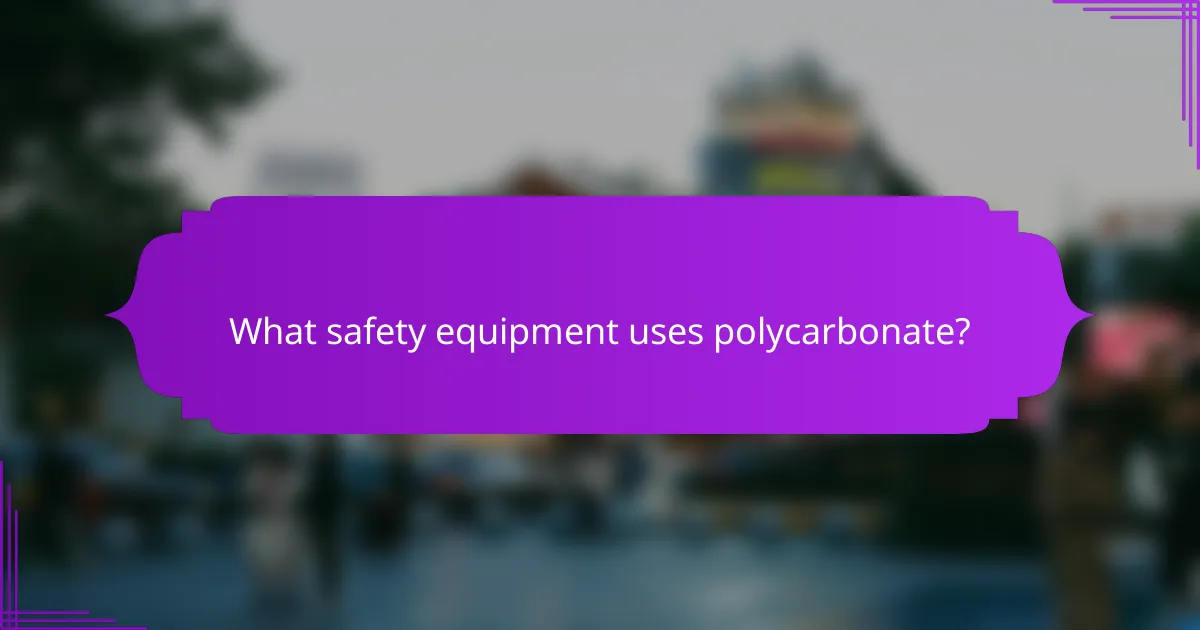
What safety equipment uses polycarbonate?
Polycarbonate is widely used in safety equipment due to its high impact resistance and lightweight properties. This material is essential for protective gear such as goggles and face shields, providing reliable protection in various hazardous environments.
Polycarbonate safety goggles
Polycarbonate safety goggles are designed to protect the eyes from flying debris, chemicals, and harmful radiation. They are often used in construction, laboratories, and manufacturing settings where eye safety is paramount.
When selecting polycarbonate goggles, consider features like anti-fog coatings and UV protection. Look for goggles that meet ANSI Z87.1 standards to ensure adequate safety and performance.
Polycarbonate face shields
Polycarbonate face shields offer full-face protection against impacts, splashes, and airborne particles. Commonly used in medical, industrial, and laboratory environments, these shields can be worn alone or in conjunction with goggles for enhanced safety.
When choosing a face shield, check for features such as adjustable headbands and anti-scratch coatings. Ensure that the shield complies with relevant safety standards, such as ANSI/ISEA 125, to guarantee effective protection.
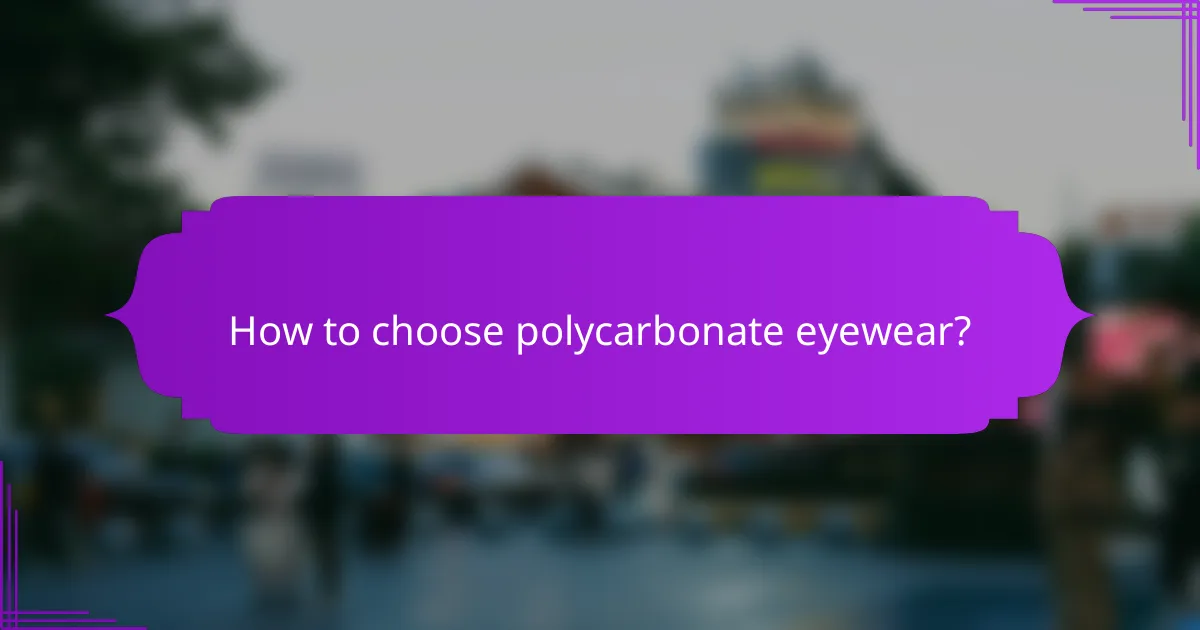
How to choose polycarbonate eyewear?
Choosing polycarbonate eyewear involves considering factors like lens coatings, frame fit, and UV protection. Prioritize your specific needs, such as prescription requirements or safety standards, to ensure optimal performance and comfort.
Consider lens coatings
Lens coatings can significantly enhance the performance and durability of polycarbonate eyewear. Common coatings include anti-scratch, anti-reflective, and UV protection, each serving a specific purpose to improve visual clarity and longevity.
For example, an anti-scratch coating helps maintain lens clarity over time, while an anti-reflective coating reduces glare, making it easier to see in bright conditions. When selecting coatings, consider your typical environment and activities to choose the most beneficial options.
Additionally, some coatings may come with added costs, so weigh the benefits against your budget. Investing in quality coatings can extend the life of your eyewear, making them a worthwhile consideration for regular users.
